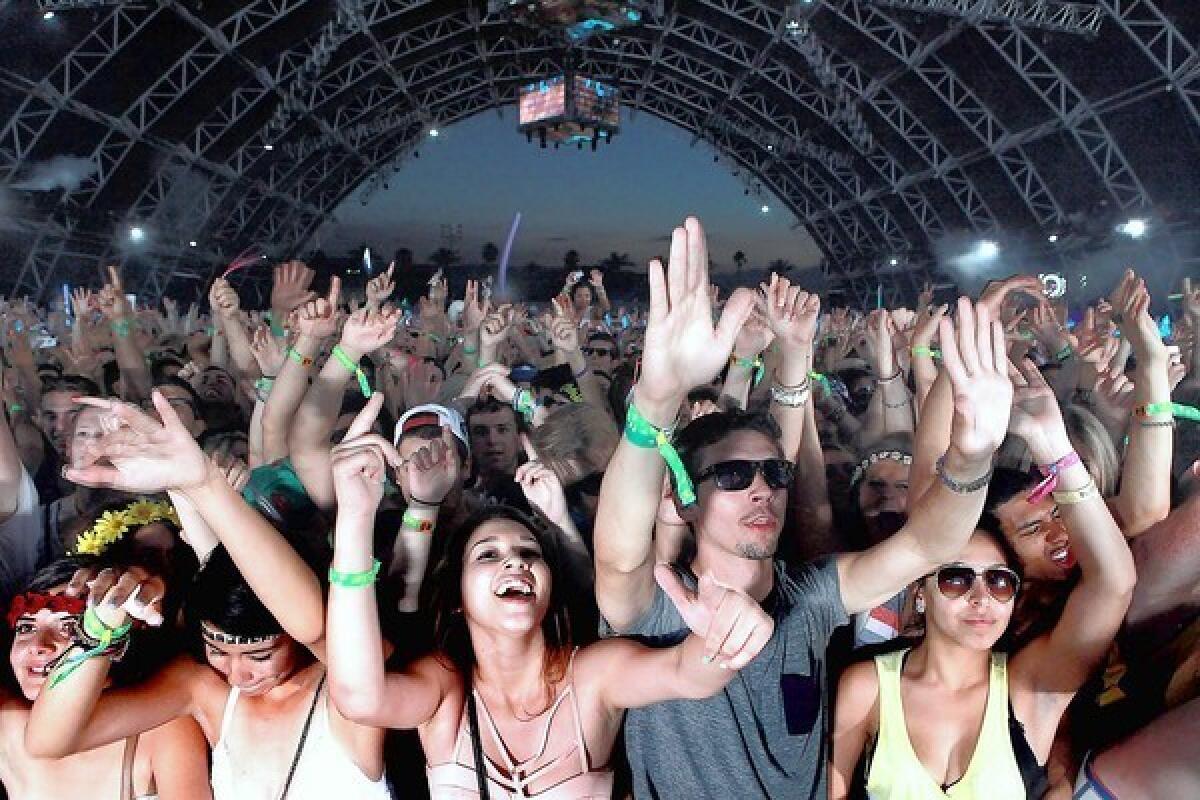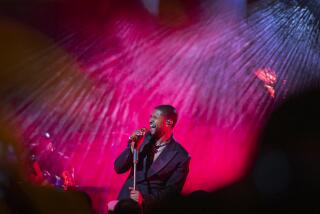Coachella 2013: Down deep in the dance grooves

The heaviest place to be at Coachella 2013, from a sound perspective, wasnât in the sweet spot of the Main Stage rig while Phoenix was preparing for the arrival of R. Kelly, or at the heart of the Sahara stage during Baauerâs big, dumb, joyous set of beat music, heavy on the synth riffs and dirty beats.
It was nestled away near the food court in the Yuma tent, where four bass cabinets the size of Jeeps were parked in each corner of the room. The tent is the sixth and newest venue at the festival, and because itâs fully enclosed, the bass canât escape. It was loud and clear even in the line outside, long all weekend long.
As the heavy rhythms of British producer Cassyâs set of minimal, bottom-heavy house and techno vibrated the disco ball spinning above, dancing worshipers moved around the speakers like moths, drawn to the rumbling hum of the bass.
COACHELLA: Festival photos since 2004 | Day 3 photos
Yes, at many other places during the first weekend of Coachella 2013, which concluded Sunday in Indio, bass was an essential, if well-balanced, ingredient. The rock fans continued their devotion to six strings and a backbeat rhythm, tackling complicated emotions with the most basic of instruments, the human voice.
L.A. band Local Natives offered a gorgeous accompaniment to sunset on Friday. The Violent Femmes reminded a new generation of its seminal teen angst debut album â which came out 30 years ago this month â by performing it in its entirety, for the first time ever. Their bassist, Brian Ritchie, replicated some of his classic solos. San Francisco band Thee Oh Sees banged out tight garage rock. At one point, the bandâs charismatic guitarist, John Dwyer, licked the body of his instrument while playing a treble-heavy solo.
While the singers were working to convey sonically balanced messages addressing universal struggles, though, the dance tents were busy roaming the lower end of the frequency range, more concerned with the rumbling of universal organs.
Bass, Miami rap producer DJ Magic Mike once theorized, is the final frontier, and in the dance tents many facets of the bottom were explored and analyzed. It was in TNGHTâs chunky set of instrumental trap music, a post-crunk sub-genre whose roots can be traced to the vibrant South Florida scene that birthed a music called Miami bass. The duo consists of producers Lunice and Hudson Mohawke, the latter of whom is affiliated with Kanye Westâs G.O.O.D. Music imprint, and their set felt like a portent.
Bass drove Major Lazerâs dub, dancehall and roots-reggae rhythms, inspired in part by the dub plates of Lee âScratchâ Perry, who performed Friday. British electronic producer and crooner James Blake offered softer but no less intense dub tones on Sunday afternoon.
It was in rapper 2 Chainzâs slow set of trap rap, which he delivered with a requisite heaviness that made the sibilant high-hats clicking above cut through with electric sizzle. While itâs yet to be determined whether the charismatic rapper, dressed in checkerboard leather pants, a Givenchy T-shirt and many gold ropes, is this yearâs Lil Jon or a could-be Lil Wayne, the sound he delivered relied on the insistent, at times nearly sub-harmonic, bass to make its point.
COACHELLA 2013: What to see and do | Timeline | Full coverage
Elsewhere, the tents trended further toward impatient, synthetic aggression to go with its bottom-end fetish. Unlike the well-coiffed European handsome men who populate the DJ booths of the Electric Daisy Carnival circuit, artists such as Bassnectar, Dog Blood and Grimes pushed out thick, distorted chord-clusters that wrapped around equally noisy bass lines. They did so while banging their heads â or, in the case of Grimes, danced as she played keyboards â urging the excited revelers to go deeper.
During his set, for example, âHarlem Shakeâ producer Baauer worked to keep his baseball cap on, but his heave-ho rhythms propelled his noggin like a punk working a riff, and the hat flew off.
Throughout his set, Moby, sporting a Black Flag T-shirt, played insistent techno, digging into his crates to offer stomping fury while raising his fists and flashing devil horns.
But then, it makes sense that this year saw more crowd surfers in the dance tents: Many of the DJs, recall, were reared on Nirvana, Korn, Nine Inch Nails, Notorious B.I.G., Daft Punk and Goldie. They were down with O.P.P. from the day they were born, and they channeled that converged energy into their mixes, resulting in frantic, stop-and-start beats that moved from single- to double-time at will, jarring listeners with sudden shifts of tempo.
At the main stage on Saturday night, during its song âOver and Over,â English dance-pop band Hot Chip sang of the pure joy of repetition, of getting lost inside a rolling groove at full volume. Itâs been one of the defining characteristics of electronic dance music since its birth, and during Cassyâs set in the Yuma, it mesmerized me onto the dance floor. But in the Sahara tent and throughout the EDM scene at Coachella, repetition was often the enemy, and the result was music created for a shock-and-awe generation looking for escape down a wormhole of noise, rhythm and lots and lots of bass.
PHOTOS AND MORE
COACHELLA 2013: Full coverage
THE ENVELOPE: Awards Insider
PHOTOS: Grammy top winners
More to Read
The biggest entertainment stories
Get our big stories about Hollywood, film, television, music, arts, culture and more right in your inbox as soon as they publish.
You may occasionally receive promotional content from the Los Angeles Times.










